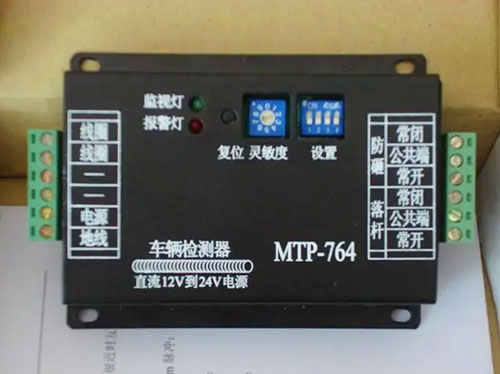Classification:
Toroidal detector
Annular coil type vehicle detector (also known as ground sensing, mostly buried detection system)
The loop detector is a traditional traffic detector, which is the most used detection equipment in the world. The magnetic field of the coil is changed by the vehicle through the annular coil buried under the road surface. Based on this, the detector calculates the traffic parameters of the vehicle, such as flow, speed, time occupancy and length, and transmits them to the central control system to meet the needs of the traffic control system. This method has the advantages of mature technology, easy to master and low cost.
This method also has the following disadvantages: a. The coil must be installed or maintained directly into the lane, which can temporarily impede traffic. b. The slit of embedded coil softens the road surface, which is easy to damage the road surface, especially at the intersection with signal control, and the damage may be more serious when the vehicle starts or braking. c. Induction coil is susceptible to freezing, subgrade subsidence, salt and alkali and other natural environment. d. Due to the limitation of its own measurement principle, when the traffic flow is congested and the workshop distance is less than 3m, the detection accuracy of induction coil is slightly decreased, and some manufacturers' products can not even be detected.
The performance index of coil detection type vehicle detector:
| Stuck mouth | |
| project | index |
| Power supply | 12V DC(7V~14V) |
| Coil inductance range | 20uH~900uH |
| sensitivity | Grade 8 adjustable (0.125%~ 1%) |
| Maximum delay | 5ms,10ms,15ms,30ms four levels adjustable |
| frequency | 2-stage adjustable (50kHz~500KHz) |
| Timeout automatic reset time | 25s,150s,210s,310s four levels adjustable |
| LED indicator | Power supply, detection status, error status |
| output | Switching quantity or level quantity |
| Operating temperature | -25℃~85℃ |
Common wave frequency detector
Wave frequency vehicle detector (mostly suspension detection system)
The wave-frequency vehicle detector is a detector that generates induction of electromagnetic wave emitted by vehicles, such as microwave, ultrasonic and infrared. This paper mainly introduces the microwave vehicle detector (RTMS), which is a kind of traffic detector with low price and superior performance, and can be widely used in the traffic information detection of urban roads and highways.
Microwave vehicle detectors (RTMS) work by side-hanging, emitting continuous low-power modulated microwaves in a sector area and leaving a long projection on the road surface. The RTMS divides the projection into 32 layers with a "layer" of 2 meters. The user can define the detection area as one or more layers. According to the echo returned by the detected target, RTMS calculates the traffic information of the target, and sends it to the control center through RS-232 at regular intervals. Its speed detection principle is: according to the specific area of all models assume a fixed length, through the induction projection area of the vehicle entry and departure experience time to calculate the speed. An RTMS side mount can simultaneously detect vehicle flow, road occupancy and speed in 8 lanes.
The measurement method of microwave vehicle detector (RTMS) has high accuracy on the road with single vehicle type, stable traffic flow and uniform speed distribution. However, in the road with congested traffic flow, many large vehicles and uneven vehicle type distribution, the measurement accuracy will be greatly affected due to occlusion. In addition, the microwave detector requires a space of 3m away from the nearest lane. For the detection of 8 lanes, 7-9m away from the nearest lane is required and the installation height meets the requirements. Therefore, the installation of Bridges, overpasses and viaducts will be limited, difficult to install and expensive.
Video detector
The video vehicle detector uses the video camera as the sensor, and sets a virtual coil in the video range, namely the detection area. When the vehicle enters the detection area, the gray value of the back scene changes, so as to know the existence of the vehicle, and thus detect the flow and speed of the vehicle. The detector can be installed above and on the side of the lane. Compared with the traditional traffic information acquisition technology, the traffic video detection technology can provide video images on the spot and move the detection coil according to needs. It has the advantages of intuitive and reliable, convenient installation, debugging and maintenance, cheap price, etc. The disadvantage is that it is easily affected by environmental factors such as bad weather, lights, shadows, etc. The dynamic shadow of the car will also bring interference, and the correct detection rate will be reduced by bad weather, or even undetectable. Environmental factors such as lights and shadows also increase the false detection rate.




